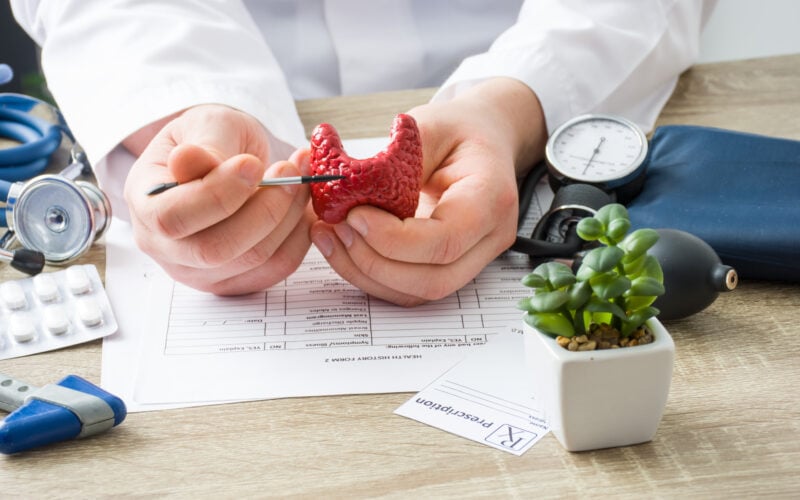PART III
Hashimoto’s thyroiditis is the auto-immune cause of thyroid dysfunction. It is the most common culprit of thyroid dysfunction in young women. It is therefore fitting that we wrap up our three-part series on thyroid dysfunction with a “crash course” on Hashimoto’s thyroiditis.
Testing for Hashimoto’s thyroiditis
In an otherwise healthy, pre-menopausal woman with hypothyroidism symptoms, it is imperative to test for thyroid antibodies. These antibodies include Anti-TPO (Anti-Thyroid Peroxidase Antibodies) and TgAb (Anti-Thyroglobulin Antibodies).
Any positive antibodies will give the diagnosis of Hashimoto’s, regardless of the results of other thyroid labs. Why? Because Hashimoto’s causes fluctuating thyroid hormones as the body’s immunity waxes and wanes. So, one day your thyroid labs may look fine, and the next they may reveal a severe deficiency.
If the presence of these thyroid antibodies continues for the long-term, it will eventually destroy the thyroid gland. But, if caught early enough, the damage can be reversed.
Symptoms of Hashimoto’s
Symptoms of Hashimoto’s may also fluctuate day to day. Symptoms can even alternate between hyperthyroidism and hypothyroidism symptoms, or there may be long stretches of being asymptomatic.
We discussed hypothyroidism (low/underactive thyroid) symptoms in Part I of our series on thyroid disorders, as well as how hypothyroid disorder might be detected from signs in a woman’s fertility awareness method (FAM) cycle charts. (We also discussed treatment of hypothyroid in Part II.)
Given that signs and symptoms of Hashimoto’s thyroiditis can alternate between those of hypothyroidism and hyperthyroidism, let’s recap the symptoms of hypothyroid (underactive thyroid) and also look at the symptoms of hyperthyroid (overactive thyroid) disorder, and how both dysfunctions may show up in a woman’s FAM chart.
Symptoms of hypothyroid dysfunction can include:
- fatigue
- muscle weakness
- long recovery time after exercise
- requiring more sleep than most
- insomnia, depression
- PMS (not improved after a trial of progesterone replacement)
- anxiety
- feeling cold
- acid reflux or heartburn
- poor appetite (especially in the morning)
- constipation
- thin eyebrows (especially the outer third), thinning hair, or sparse eyelashes
- dry skin or eyes
- acne
- headaches or migraines
- puffy face, fingers, or feet
- easily broken or peeling fingernails
- foggy head, inability to concentrate, or poor memory
- difficulty losing weight
- heavy long, and/or irregular periods
- poor immune function / getting sick frequently
In FAM charts, signs of hypothyroidism can show up as:
- long follicular phase
- variable luteal phase
- heavy periods
- brown bleeding at the end of each period (lasting for more than 2 days)
- consistently low basal body temperatures
Symptoms of hyperthyroid dysfunction may include:
- anxiety
- insomnia
- fatigue
- high heart rate / palpitations
- always feeling hot / heat sensitive
- muscle weakness
- diarrhea
- unintended weight loss / difficulty gaining weight
In FAM charts, signs of hyperthyroidism can show up as:
- consistently elevated basal body temperatures
- break-through bleeding / spotting mid-cycle
- tail-end brown bleeding (brown bleeding at the end of menses)
- short cycles / short post-ovulatory phase
- anovulation
Treatment of Hashimoto’s
Treatment of Hashimoto’s can be tricky. If there is low thyroid function, then treating with T4 and/or T3 is important not only to reduce symptoms, but to also lower the level of thyroid-destroying antibodies. However, if fluctuations occur between hyper and hypo, adding T3 may worsen the hyper symptoms.
Therefore, the key to effective treatment is decreasing the antibodies. To do this, lifestyle issues that may worsen the immune system must be addressed, including: stress, poor diet, insufficient intake of key vitamins and minerals, poor sleep hygiene, sleep apnea, dehydration, chronic allergies, and eating foods to which the body has a sensitivity.
To address this last stressor, I highly recommend up to three months of the Anti-inflammatory Protocol diet to eliminate food sources of inflammation. If this seems to be an impossible task, eliminating gluten, at minimum, can still be effective. Gluten has been highly implicated in Hashimoto’s due the leaky gut that it can cause, which consequently leads to inflammation and malabsorption.
Finally, I recommend reducing endocrine disruptors which are also implicated in inflammation. The toxins found in pesticides, heavy metals, phthalates, and bisphenol A (BPA), are all known endocrine disruptors, along with the birth control pill. Anti-inflammatory supplements like Vitamin C, N-Acetylcysteine, and Co-Q10 have also been proven to be helpful in decreasing thyroid-damaging antibodies.
Once all these suggestions have been implemented, and if thyroid antibodies are still present, Low Dose Naltrexone (3-5 mg daily) has been proven to eliminate thyroid antibodies and return thyroid function to normal. This is a prescription, so a thyroid-literate physician must give access to this life-changing treatment. It must also be noted that utilization of Naltrexone (which is an opioid antagonist) to treat hypothyroidism is an ‘off label’ (non-FDA) approved use.
More information on Hashimoto’s thyroiditis
This crash course in Hashimoto’s thyroiditis is far from complete. If you have been diagnosed with this disease, I highly recommend Janie Bowthorpe’s book Hashimoto’s: Taming the Beast for more information on symptoms, testing, and treatment.
We hope you’ve enjoyed this series on thyroid health and functioning. If you’d like to revisit Parts I and II, see the links below:
Part II: Beyond Synthroid: Seeking Complete Treatment for Hypothyroidism







